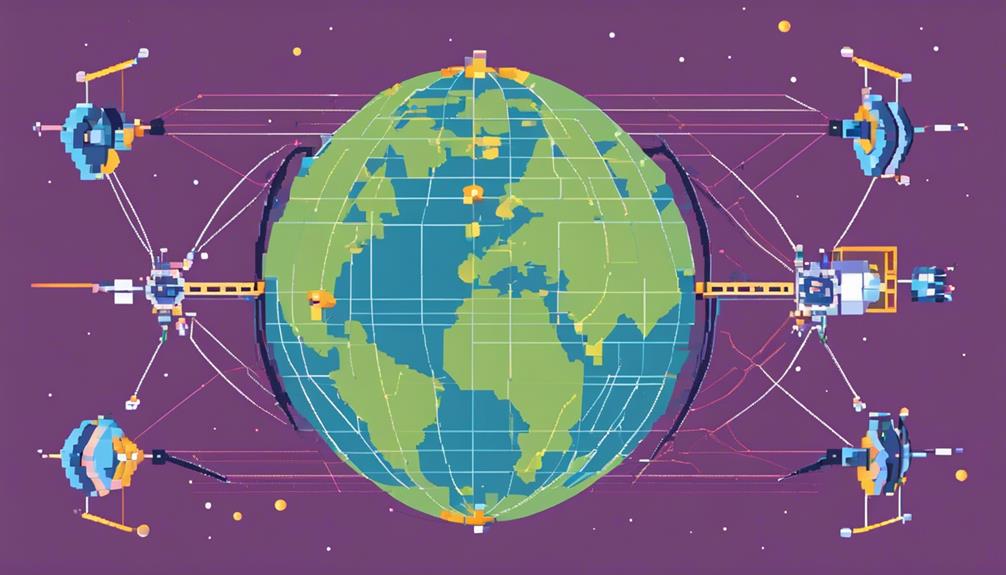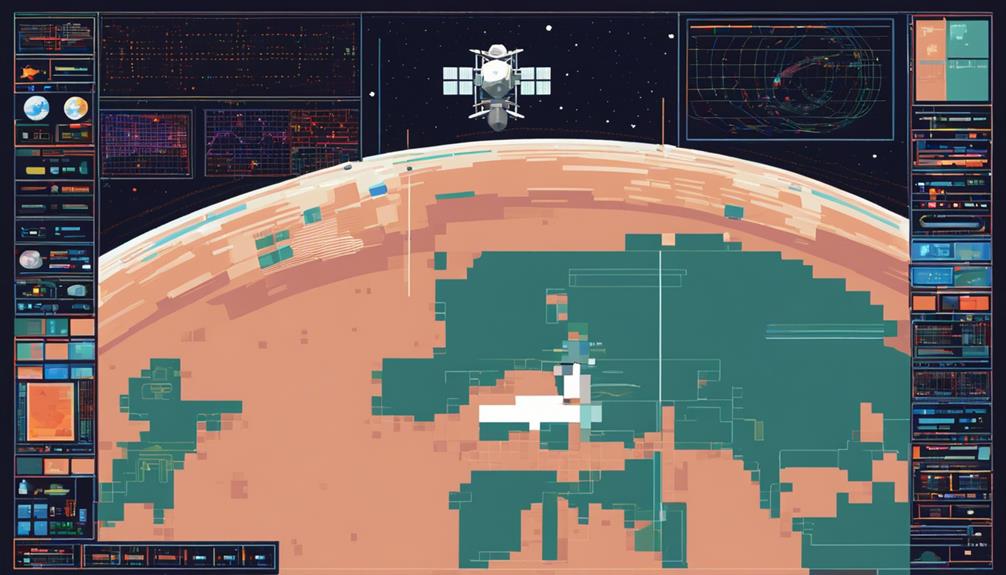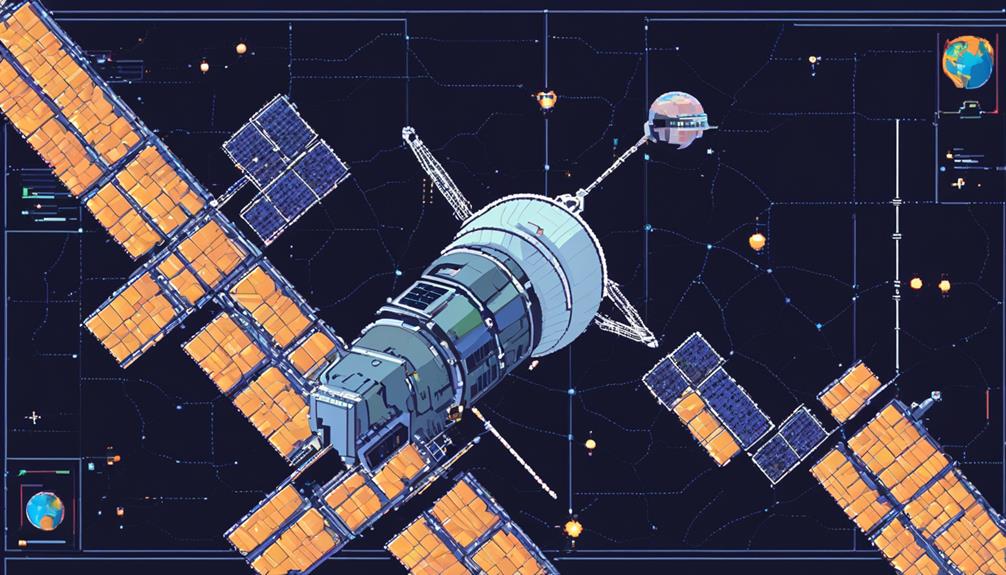Artificial Intelligence is reshaping the landscape of satellite operations by introducing cutting-edge technologies that streamline processes and enhance overall efficiency. The integration of AI in satellite systems has opened up a realm of possibilities, from autonomous navigation to advanced data analytics. By leveraging AI algorithms, satellite operators can tackle complex challenges such as space debris detection and emergency response with unprecedented accuracy and speed. The application of AI in satellite operations not only marks a significant technological advancement but also raises intriguing questions about the future of space exploration and defense strategies. The intricate dance between AI and satellite operations holds promise for a future where space technologies operate with unprecedented precision and intelligence.
Key Takeaways
- AI enhances spacecraft autonomy and adaptability for efficient operations.
- Machine Learning Operations streamline AI application deployment.
- AI supports anti-collision maneuvers and swift reaction to changes.
- AI integration optimizes satellite maneuvering and improves mission success rates.
AI for Autonomous Satellite Navigation

In the realm of satellite operations, the implementation of artificial intelligence (AI) for autonomous navigation has revolutionized the capabilities of satellites by enabling them to make independent decisions and adjustments in their trajectories without human intervention. Satellites equipped with AI-driven autonomous navigation systems exhibit enhanced efficiency and adaptability in maneuvering through space. These AI algorithms play a critical role in ensuring optimal satellite performance by assisting in collision avoidance, route optimization, and real-time responses to dynamic space conditions.
The integration of AI into satellite navigation systems enables these spacecraft to operate with a level of autonomy that was previously unattainable. By leveraging AI technology, satellites can analyze vast amounts of data, predict potential obstacles or hazards, and autonomously adjust their paths to avoid collisions or optimize their routes efficiently. This capability is particularly valuable in scenarios where immediate responses are required to ensure the safety and reliability of space missions.
Data Processing Advancements With AI
Advancements in artificial intelligence (AI) have significantly improved data processing capabilities onboard satellites, leading to faster and more efficient analysis of satellite data. This progress is crucial for enhancing spacecraft operations. Here are three ways AI is revolutionizing data processing in satellite operations:
- Enhanced Image Quality: AI algorithms, such as those employed in ESA's OPS-SAT projects, play a pivotal role in improving spacecraft image quality. By leveraging AI for feature detection and image enhancement, satellites can capture clearer and more detailed images, facilitating better analysis of the data received.
- Reinforcement Learning for Orientation Control: AI techniques like reinforcement learning are utilized to enhance spacecraft orientation control. By continuously learning and optimizing control strategies, satellites can adjust their orientation more effectively, leading to improved data collection and transmission processes.
- Efficient Marine Litter Detection: AI assists in detecting and tracking marine litter by analyzing data from satellites and drones. This application showcases how AI can streamline the process of identifying and monitoring environmental phenomena from space, contributing to more effective spacecraft operations and environmental management.
Anomaly Detection Using Artificial Intelligence

Anomaly detection using artificial intelligence in satellite operations plays a critical role in identifying irregularities within satellite systems or data streams. By leveraging AI algorithms to scrutinize extensive telemetry data, anomalies indicative of potential malfunctions or security breaches can be swiftly pinpointed. Employing machine learning models trained on historical data enables the timely recognition of patterns and deviations, facilitating proactive responses and safeguarding the operational integrity of satellite systems.
AI for Anomaly Detection
Utilizing sophisticated machine learning algorithms, artificial intelligence plays a pivotal role in the detection of irregularities within satellite operations through the analysis of telemetry data. AI for anomaly detection in satellite systems offers several key advantages:
- Identification of Deviations: AI is adept at identifying anomalies or deviations from normal behavior in satellite systems.
- Enhanced Predictive Capabilities: Machine learning algorithms enable the prediction and prevention of potential failures by analyzing satellite telemetry data.
- Continuous Monitoring: AI-powered anomaly detection ensures continuous monitoring of satellite behavior, promptly alerting operators to abnormal patterns or malfunctions, thereby enhancing the overall reliability and efficiency of satellite missions.
Benefits of AI
In the realm of satellite operations, the integration of artificial intelligence for anomaly detection not only ensures the identification of deviations but also brings forth a myriad of benefits that significantly enhance operational efficiency and reliability. By leveraging advanced machine learning algorithms, AI enables the proactive detection of potential malfunctions or threats within satellite systems. This capability reduces the need for manual monitoring efforts and allows for real-time responses to issues, thereby enhancing operational efficiency. Furthermore, AI's continuous learning from data patterns enhances its anomaly detection capabilities over time, contributing to improved satellite system reliability. Ultimately, anomaly detection using AI in satellite operations plays a crucial role in preventing potential disruptions and ensuring the optimal functioning and performance of satellite missions.
AI Integration in Satellite Operations
The integration of artificial intelligence (AI) into satellite operations revolutionizes spacecraft autonomy and adaptability, enabling advanced decision-making capabilities. AI algorithms play a crucial role in enhancing satellite operations through autonomous decision-making and improved operational efficiency. Here are three key ways AI integration is transforming satellite operations:
- Autonomous Decision-Making: AI integration enables satellites to make decisions independently, enhancing their ability to react swiftly to changing scenarios in space. This autonomy reduces the reliance on ground control and allows satellites to adapt to unforeseen circumstances effectively.
- Enhanced Safety Measures: AI algorithms support anti-collision maneuvers by analyzing and predicting potential collision risks in space. Additionally, AI aids in detecting missile launchers from space, providing early warnings and enhancing overall safety measures for satellites.
- Operational Efficiency: Machine Learning Operations (MLOps) capabilities streamline the deployment and scaling of AI applications in satellite operations. This efficiency allows for faster implementation of AI technologies, optimizing satellite performance and mission success.
Incorporating AI into satellite operations not only advances technological capabilities but also ensures responsible and ethical use of these powerful tools in space missions. By leveraging AI integration, satellite operations can achieve higher levels of efficiency, safety, and autonomy in the dynamic environment of space.
AI in Satellite Maneuvering

AI integration in satellite operations has significantly improved spacecraft autonomy and adaptability, particularly in the realm of satellite maneuvering where real-time data analysis and autonomous adjustments play a pivotal role. By leveraging AI technologies, satellites can autonomously analyze real-time data and adjust trajectory parameters to optimize orbits for efficient communication and observation missions. This capability is crucial for enhancing operational efficiency, reducing response time, and improving overall mission success rates.
One of the key applications of AI in satellite maneuvering is in space debris management. AI-based collision avoidance systems are used to predict and avoid potential space debris threats, ensuring the safety of satellites in orbit. These systems enable autonomous decision-making, allowing satellites to adapt to changing space conditions without the need for human intervention. By continuously monitoring the surrounding environment and making real-time adjustments to their trajectories, satellites can navigate through space debris fields more effectively.
The table below provides a visual representation of the impact of AI on satellite maneuvering:
| AI in Satellite Maneuvering | |
|---|---|
| Optimizes satellite orbits | Enhances operational efficiency |
| Enables collision avoidance | Improves mission success rates |
| Facilitates autonomous decision-making | Ensures satellite safety |
Enhanced Satellite Communication With AI
Artificial Intelligence plays a pivotal role in enhancing satellite communication by optimizing data transmission, reducing latency, and improving overall signal quality. Additionally, AI-driven machine learning algorithms help in predicting and mitigating signal interference, ensuring a reliable and uninterrupted communication network. These AI-enabled satellite communication systems can adapt to changing network conditions, maximizing bandwidth utilization and network efficiency for improved performance.
Improved Signal Quality
Enhancing satellite communication through advanced signal quality optimization techniques is crucial for ensuring reliable data transmission in satellite operations. AI plays a pivotal role in improving signal quality by employing sophisticated algorithms and processing methods. Here's how AI enhances signal quality in satellite communication:
- Dynamic Parameter Adjustment: AI utilizes machine learning algorithms to dynamically adjust communication parameters, optimizing signal strength based on real-time conditions.
- Interference Mitigation: AI-driven signal processing techniques help mitigate signal interference and noise, ensuring clearer reception and transmission of data.
- Predictive Maintenance: By analyzing communication patterns, AI can predict signal disruptions and take proactive corrective actions to maintain uninterrupted connectivity.
Through these methods, AI-enabled satellite communication systems ensure optimal signal quality and efficient data transfer.
Predictive Maintenance Solutions
In the realm of satellite communication operations, the integration of predictive maintenance solutions empowered by advanced algorithms is pivotal for ensuring the continuous functionality and reliability of satellite systems. AI-driven predictive maintenance plays a crucial role in enhancing satellite communication reliability by proactively identifying maintenance needs, optimizing performance, and reducing downtime. By analyzing vast amounts of satellite data, these solutions can predict potential issues before they occur, thus extending the lifespan of satellites, improving operational efficiency, and reducing maintenance costs. Real-time monitoring of satellite health parameters enables AI algorithms to detect anomalies promptly and recommend preventive actions to prevent system failures. The implementation of AI-powered predictive maintenance solutions is essential for guaranteeing uninterrupted and dependable communication services in space.
Real-Time Anomaly Detection
Realizing the critical role of AI-driven real-time anomaly detection in satellite communication operations, the focus shifts towards leveraging advanced algorithms to enhance system reliability and performance.
Key Points:
- AI analyzes vast data to detect abnormalities and potential issues promptly.
- Machine learning algorithms improve satellite communication signal anomaly detection.
- Real-time anomaly detection leads to reduced downtime and enhanced operational efficiency.
AI for Satellite Imaging
Utilizing artificial intelligence (AI) in satellite operations revolutionizes the field of satellite imaging by significantly enhancing image processing and analysis capabilities. With satellite imaging producing over 150 Terabytes of data daily, the integration of AI-driven solutions has become essential to handle and extract valuable insights from this vast amount of information. AI plays a crucial role in improving the quality of satellite imagery by refining image processing techniques, enabling satellites to autonomously detect and track specific features on Earth's surface.
Moreover, AI-powered autonomous navigation is being explored to streamline satellite imaging missions. By leveraging reinforcement learning techniques, spacecraft orientation can be optimized to maximize the quality of captured images. This autonomous navigation not only enhances the efficiency of satellite operations but also contributes to improved surveillance capabilities through more precise and targeted imaging.
In essence, AI is at the forefront of transforming satellite imaging by introducing advanced technologies that enable satellites to operate more independently and effectively. As the demand for high-quality satellite imagery continues to grow, the integration of AI in satellite operations will undoubtedly play a pivotal role in shaping the future of satellite imaging.
AI in Space Data Analysis

AI's integration into space data analysis has revolutionized object detection tasks within satellite imagery, propelling advancements in capabilities like counting and classification from space-based platforms. AI systems are transforming space data analysis in the following ways:
- Automated Object Detection: AI algorithms automate the process of scanning vast amounts of satellite images to identify specific objects of interest, such as missile launchers or other targets. This automation greatly speeds up the analysis process and enhances the accuracy of identifying objects in space imagery.
- Enhanced Capabilities: Advancements in AI technologies enable future capabilities in space data analysis, including object detection, counting, and classification from satellites. These capabilities help in monitoring and analyzing various activities on Earth's surface, providing valuable insights for different applications.
- Activity-Based Intelligence: AI-powered activity-based intelligence systems can predict behaviors and activities on Earth's surface by analyzing satellite data. This predictive capability enhances situational awareness and aids in decision-making processes related to space operations and defense systems.
The integration of AI systems in space data analysis not only improves the efficiency and accuracy of object detection tasks but also plays a crucial role in enhancing operational effectiveness and security in satellite operations.
AI for Satellite Telemetry
AI for satellite telemetry plays a crucial role in enhancing data analysis efficiency and fault prediction capability. By utilizing artificial intelligence, satellite operators can streamline the process of extracting valuable insights from telemetry data. This technology enables proactive measures to be taken in response to potential satellite anomalies, ensuring optimal performance and operational effectiveness.
Data Analysis Efficiency
Enhancing the efficiency of satellite telemetry data analysis through artificial intelligence has become integral to optimizing operational processes and ensuring seamless performance. AI algorithms play a crucial role in this process by:
- Real-time Monitoring: AI enhances satellite telemetry by continuously monitoring data streams in real-time, leading to improved operational efficiency.
- Quick Analysis: With vast amounts of satellite telemetry data to analyze, AI algorithms assist in swiftly interpreting the information, enabling rapid decision-making.
- Optimized Control: AI aids in optimizing satellite control and telemetry, ensuring smooth operations and enhanced performance through proactive monitoring and reduced human errors.
Fault Prediction Capability
Utilizing advanced machine learning algorithms, fault prediction capability in satellite telemetry is revolutionizing the proactive maintenance approach for satellite operations. By analyzing historical data and patterns, AI can detect anomalies in satellite telemetry data, enabling the prediction of potential failures before they occur. This predictive maintenance using AI allows satellite operators to schedule necessary repairs or interventions proactively, reducing downtime and ensuring continuous and reliable operation in space. Through AI-driven fault prediction, maintenance schedules can be optimized, leading to enhanced overall mission success. The table below illustrates the impact of fault prediction capability on satellite operations:
| Benefits of Fault Prediction Capability |
|---|
| Early detection of potential failures |
| Proactive maintenance scheduling |
| Reduced downtime of satellites |
| Enhanced mission success |
AI-Driven Space Mission Planning

By leveraging advanced computational algorithms, satellite operators can enhance the efficiency of mission planning through the use of artificial intelligence technology. AI-driven space mission planning employs machine learning algorithms to optimize satellite operations, ensuring the autonomous generation of efficient mission schedules. Here are three key aspects highlighting the significance of AI in this domain:
- Data Analysis: Machine learning algorithms analyze vast amounts of data, including historical mission data, satellite capabilities, and environmental factors. This analysis enables more informed decision-making in satellite mission planning, leading to optimized schedules and resource allocation.
- Constraint Consideration: AI systems take into account various constraints such as power limitations, communication availability, and payload requirements when creating mission plans. By considering these constraints alongside mission objectives, AI can generate optimal plans that maximize efficiency and operational success.
- Autonomous Planning: Through AI-driven mission planning, the need for human intervention in creating schedules is significantly reduced. This autonomous planning capability streamlines satellite operations, improves resource utilization, and enhances overall mission effectiveness. Additionally, AI-based planning enhances satellite responsiveness and adaptability to dynamic space environments, ensuring that missions can quickly adjust to changing conditions for optimal performance.
AI for Satellite Health Monitoring
AI for Satellite Health Monitoring is crucial in ensuring the optimal performance and longevity of satellites by automatically gathering measurements and sharing core component health updates with engineers. By utilizing artificial intelligence (AI) in satellite operations, the monitoring of satellite health becomes more efficient and effective. This automated process not only aids in identifying potential issues early but also enhances operational efficiency by providing real-time insights into the status of critical components.
| Benefits of AI in Satellite Health Monitoring | |
|---|---|
| Early Issue Identification | Efficient Monitoring of Core Components |
| Optimal Performance | Longevity of Satellites |
AI plays a significant role in monitoring telemetry data, offering valuable feedback for satellite control, and ultimately optimizing operational efficiency. Through the automatic execution of maintenance tasks based on AI analysis, the capabilities of satellite health monitoring are further enhanced. This proactive approach ensures that satellites are operating at their best, reducing the likelihood of malfunctions and extending their operational lifespan. In essence, AI for satellite health monitoring is a cornerstone in maintaining the reliability and effectiveness of satellite operations.
AI for Space Debris Detection
Detection and tracking of space debris, including defunct satellites and rocket stages, is facilitated through advanced AI algorithms analyzing satellite imagery and sensor data to assess collision risks with active satellites and spacecraft. Space debris poses a significant threat to operational satellites in orbit, highlighting the importance of AI in providing early warning and collision avoidance strategies. Here are key aspects of AI for space debris detection:
- Automated Detection: AI algorithms enable the automated identification of space debris in satellite imagery and sensor data, allowing for swift and accurate detection of potential collision risks.
- Collision Risk Assessment: By analyzing the trajectory and characteristics of space debris using AI, satellite operators can assess the probability of collisions with active satellites and spacecraft, enabling timely preventive measures.
- Enhanced Space Monitoring: AI-based space debris detection enhances the monitoring capabilities of satellite operators and space agencies, enabling them to track the movement of debris more effectively and safeguard critical space assets.
AI-Based Satellite Security Measures
Satellite security measures are significantly bolstered through the strategic implementation of artificial intelligence technologies, particularly in the realm of proactive cybersecurity defense against potential cyber threats. AI plays a crucial role in enhancing satellite security by detecting and preventing cyber attacks on satellites. AI algorithms are utilized to identify and mitigate potential vulnerabilities in satellite systems, ensuring secure operations. Satellite operators leverage AI for real-time monitoring and anomaly detection to safeguard against unauthorized access and manipulation. By employing AI-driven cybersecurity applications, proactive defense mechanisms are established to counter evolving threats to satellite systems. Additionally, AI is instrumental in ensuring the integrity and protection of satellite signals against malicious actors in the space domain.
| AI Applications in Satellite Security | Benefits |
|---|---|
| Detection and prevention of cyber attacks | Enhanced security |
| Identification and mitigation of vulnerabilities | Secure operations |
| Real-time monitoring and anomaly detection | Protection against unauthorized access |
AI in Satellite Emergency Response

AI in satellite emergency response plays a crucial role in rapidly detecting emergencies such as wildfires, floods, and earthquakes. By utilizing automated response systems, AI enables quick and efficient identification and assessment of natural disasters. This technology aids in optimizing resource allocation, decision-making processes, and ultimately contributes to saving lives in crisis situations.
Rapid Emergency Detection
Utilizing advanced algorithms and satellite data analysis, artificial intelligence systems play a pivotal role in swiftly identifying and responding to natural disasters in emergency situations. AI in satellite emergency response enables rapid detection of various natural disasters, including wildfires, floods, and earthquakes. Through the processing of satellite data using AI algorithms, emergency situations can be quickly identified, allowing for prompt response efforts. The integration of AI-powered satellite systems offers real-time monitoring and early warning capabilities, significantly enhancing the efficiency and effectiveness of disaster response operations. This automated emergency detection not only reduces the time required to identify emergencies but also provides crucial support in mitigating the impact of such events.
Automated Response Systems
Incorporating automated response systems equipped with advanced AI algorithms revolutionizes the emergency response capabilities within satellite operations. AI-enabled emergency response systems enable rapid decision-making, swiftly assessing, analyzing, and executing necessary actions without human intervention. These systems enhance satellite resilience by promptly responding to anomalies or threats, ultimately improving mission success rates through reduced response times and increased operational efficiency. By integrating AI in emergency response systems, satellites can better adapt to the dynamic and challenging space environments they encounter.
| Benefits of AI in Satellite Emergency Response Systems | |
|---|---|
| Swift Decision-making | Enhanced Resilience |
| Reduced Response Times | Improved Operational Efficiency |
| Adaptability to Dynamic Environments | Increased Mission Success Rates |
Future of AI in Satellite Operations
The upcoming advancements in satellite operations will revolutionize mission efficiency through the implementation of cutting-edge autonomous decision-making and problem-solving technologies. AI integration in satellite operations is poised to bring about significant improvements, particularly in the following areas:
- Autonomous Navigation: AI will enable satellites to navigate independently, making real-time adjustments to their trajectories based on various factors like orbital debris or unexpected obstacles. This capability will enhance operational efficiency and reduce the risk of collisions in space.
- Collision Avoidance: Through AI-powered algorithms, satellites will be able to detect potential collision threats and autonomously maneuver to avoid accidents. This proactive approach to collision avoidance will safeguard satellite assets and prevent disruptions to critical missions.
- Optimization of Operations: AI will play a crucial role in streamlining satellite operations by optimizing tasks such as telemetry monitoring, data analysis, and maneuver planning. By leveraging AI for these functions, satellite operators can enhance decision-making processes and respond more effectively to dynamic mission requirements.
The future of AI in satellite operations holds immense potential for advancing the capabilities of spacecraft and enhancing overall mission success rates. By embracing AI-driven solutions, the satellite industry is poised to enter a new era of efficiency, safety, and innovation.
Frequently Asked Questions
How Does Spacex Use Ai?
SpaceX employs AI in various facets of its operations, utilizing machine learning algorithms for autonomous spacecraft control. These applications range from precision landing of rocket boosters at sea to real-time decision-making during missions and optimizing engine performance. Neural networks aid in trajectory adjustments and fuel efficiency, while predictive maintenance through AI ensures mission success. The integration of AI technologies enhances SpaceX's capabilities across multiple aspects of spaceflight operations.
How Does NASA Use Artificial Intelligence?
NASA leverages artificial intelligence in diverse applications, yielding significant benefits. AI algorithms enhance performance across various tasks, from autonomous navigation for spacecraft precision to analyzing vast satellite data for Earth observation. By harnessing AI, NASA optimizes space weather predictions and protects satellites from solar events. Through efficient network optimization, AI aids in enhancing satellite communication. Overall, NASA's use of AI underscores its commitment to innovation and operational excellence in space exploration.
Will AI Help Space Travel?
AI will significantly benefit space exploration by advancing machine learning algorithms for autonomous decision-making and mission planning. Robotics enhanced by AI will aid astronaut assistance in challenging environments, improving safety and efficiency during space travel. These technological advancements promise to revolutionize space missions by optimizing resource utilization, enhancing data processing capabilities, and enabling more sophisticated exploration strategies. The integration of AI will undoubtedly play a pivotal role in shaping the future of space exploration.
What Can AI Use Satellite Imaging For?
AI can use satellite imaging for various applications, including agricultural monitoring and disaster response. In agricultural monitoring, AI analyzes satellite images to assess crop health, predict yields, and optimize farming practices. During disaster response, AI leverages satellite data to assess damage, prioritize rescue efforts, and plan recovery operations efficiently. These capabilities demonstrate the versatility and importance of AI in utilizing satellite imaging for critical tasks beyond traditional uses.

